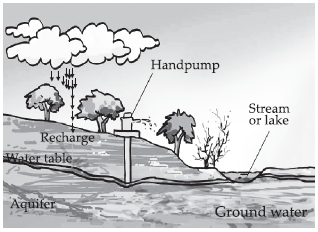Water : A Precious Resource (Biology) Class 7 - NCERT Questions
Mark ‘T’ if the statement is true and ‘F’ if it is false:
(A) The fresh water stored in the ground is much more than that present in the rivers and lakes of the world. (T/F)
(B) Water shortage is a problem faced only by people living in rural areas. (T/F)
(C) Water from rivers is the only source for irrigation in the fields. (T/F)
(D) Rain is the ultimate source of water. (T/F)
(A) T
(B) F – Water shortage is a problem faced by both people living in rural and in urban areas.
(C) F – Rivers, canals, wells, tube wells are the main sources of irrigation in the fields.
(D) T
Explain how ground water is recharged?
SOLUTION:The rainwater and water from other sources such as rivers and ponds seeps through the soil and fills the empty spaces and cracks deep below the ground. The process of seeping of water into the ground is called infiltration. By this process of infiltration, ground water gets recharged.
Q 3.There are ten tube wells in a lane of fifty houses. What could be the long term impact on the water table?
SOLUTION:Ground water is an important source of fresh water. Due to continuous drawing of water by tube wells at a particular place, and the water table not being replenished would ultimately lead to depletion of water table. Thus the long term impact will be depletion of water table and shortage of ground water in that area.
Q 4.You have been asked to maintain a garden. How will you minimise the use of water?
SOLUTION:Following ways can be adopted to minimise the use of water while maintaining a garden :
(i) By implementing drip irrigation system and sprinklers.
(ii) Watering during morning and evening hours will check the loss of water due to evaporation.
Explain the factors responsible for the depletion of water table.
SOLUTION:Some of the factors responsible for the depletion of water table are as follows:
(i) Increasing population : As our population increases, we need more water for drinking, washing, cooking, cleaning etc. Moreover , increasing population creates demand for construction of houses, shops, offices, roads and pavements. This decreases the open areas like parks and playgrounds, which in turn decreases the seepage of rainwater into the ground. Construction itself uses a lot of water — most of it being ground water. Thus, rising population leads to an increase in consumption and at the same time, a decrease in the seepage of water into the ground.
(ii) Growing industrialization : Almost all industries use water. As the number of industries increases, so does the consumption of water. Most of this water is drawn from ground water.
(iii) Agricultural activities : Increase in population has led to an increased demand for food ,causing an increase in agricultural activity. For irrigating the fields, water is used from wells, tube wells, canals etc., which results in a major downfall in the level of the water table.
(iv) Climate changes : Global warming increases the temperature of the earth. As a result the soil becomes very dry and absorbs a large amount of water. This does not let water go under the ground and thus depletes the water table.
(v) Deforestation : Vegetation slows down the flow of rainwater on land and increases the absorption of water by the soil. Cutting down of trees and destroying vegetation, therefore, interferes with the natural process by which seepage takes place and the ground water is recharged.
(vi) Insufficient rainfall : Insufficient rainfall results in the depletion of water table because the ground water does not get recharged.
(vii) Mismanagement of water resources : Mismanagement of water resources at the individual level as well as at the level of civic authorities, results in wastage of huge amount of fresh water. Such mismanagement ultimately results in loss of ground water and depletion of water table.
Fill in the blanks with the appropriate answers:
(A) People obtain ground water through ________ and ________.
(B) Three forms of water are ________, ________ and ________.
(C) The water bearing layer of the earth is ________.
(D) The process of water seepage into the ground is called ________.
(A) wells, tube wells (B) solid, liquid, gas (C) water table (D) infiltration
Q 7.Which one of the following is not responsible for water shortage?
(i) Rapid growth of industries (ii) Increasing population
(iii) Heavy rainfall (iv) Mismanagement of water resources
(iii) Heavy rainfall
Q 8.Choose the correct option. The total water (i) in the lakes and rivers of the world remains constant (ii) under the ground remains constant (iii) in the seas and oceans of the world remains constant (iv) of the world remains constant.
SOLUTION:(iv) of the world remains constant
Q 9.Make a sketch showing ground water and water table. Label it.
SOLUTION:Labelled sketch showing ground water and water table is as follows :
